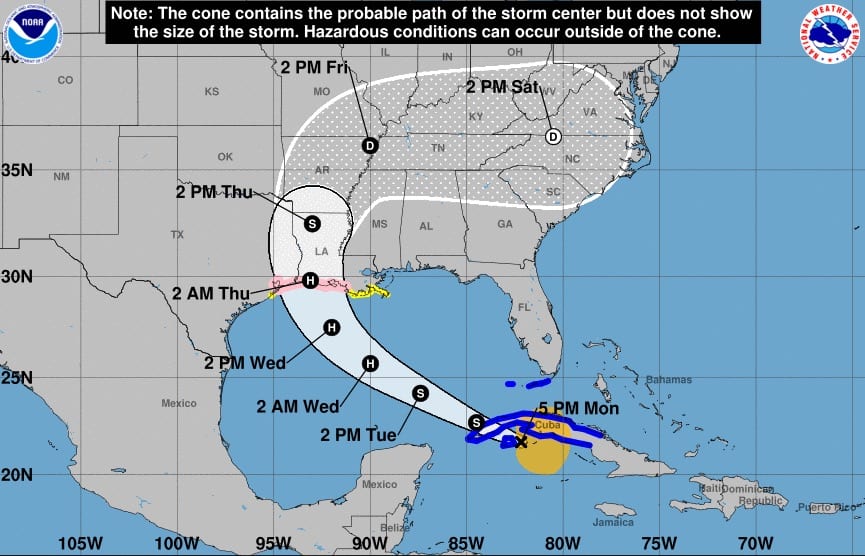Geopolitics, High Bids, and U.S. Pressure Cloud COSCO’s Global Port Ambitions
COSCO Shipping Ports is facing "challenges" with its international investments amid pressures from the U.S. trade war, its managing director said in Hong Kong on Thursday.

At 2 p.m. EDT on August 23, 2020,, the center of Tropical Storm Laura was located about 80 miles (125 km) east of the Isle of Youth.
By Brian K. Sullivan (Bloomberg) –Tropical Storm Laura is poised to become a hurricane before making landfall Thursday, posing a threat to oil and gas infrastructure on the Gulf Coast.
A hurricane watch has been posted from Port Bolivar, Texas, to west of Morgan City, Louisiana, in anticipation of Laura’s arrival, the National Hurricane Center said in an advisory at 5 p.m. New York time. Forecasts are split on whether Laura becomes a major hurricane with winds in excess of 111 miles (179 kilometers) per hour or not. Another storm, Marco, lost so much power as it approached the coast that it will likely fall apart.
“Laura is forecast to reach the northwestern Gulf Coast as a hurricane late Wednesday and early Thursday,” Dan Brown, a meteorologist at the center, wrote in his forecast. “Do not focus on the details of the official forecast” given uncertainty in predictions to three days out, he said.
Laura’s winds will be at least 105 mph, making it a Category 2 hurricane, but the storm could reach Category 3 strength on the five-step Saffir Simpson scale.
Hurricane and Storm Surge Watches have been issued for Tropical Storm #Laura. Here are the Key Messages. pic.twitter.com/nd46JsL4vl
— National Hurricane Center (@NHC_Atlantic) August 24, 2020
The tropical threat has already prompted 82% of oil output and 57% of natural gas production in the Gulf of Mexico to be shut, according to the Interior Department’s Bureau of Safety and Environmental Enforcement. If Laura becomes a Category 3, it would be the first major Atlantic hurricane of 2020.
Gulf Coast refineries and petrochemical plants are often located in low-lying areas vulnerable to flooding. In 2017, an Arkema SA chemical plant about 25 miles (40 kilometers) east of Houston had a fire and explosion after it was flooded by Hurricane Harvey. In September, Exxon shut its Beaumont refinery in Texas because of flooding from Tropical Storm Imelda.
Laura almost certainly won’t be as damaging as Harvey, however. Harvey hit Texas as a Category 4 storm and then got pinned in place by larger weather patterns, causing it to send record rains across the eastern half of the state for days. Laura may pack a severe punch at landfall, but it will quickly exit the area, reducing the potential for lingering effects. The last hurricane to hit Texas was Hanna, just under a month ago.
Energy platforms in the Gulf of Mexico that account for as much as 17% of America’s oil production and about 3% of gas output are designed to withstand storms of this magnitude; they regularly shut and restart as systems pass through.
Laura could cause problems for refineries and fuel-distribution hubs from Houston to Louisiana, said Jim Rouiller, lead meteorologist with the Energy Weather Group. Offshore platforms were retrofitted after 2005’s Hurricane Katrina to endure stronger storms, but onshore flooding could threaten the 45% of American fuel-making capacity that’s located along the Gulf Coast, as well as more than half the nation’s gas processing.
“The big issue is if it hits any of the refineries — present track is right over Lake Charles and 10% capacity at risk,” said Chuck Watson, a disaster modeler with Enki Research. “A wobble puts the north Texas coast in play.”
Motiva Enterprises LLC and Valero Energy Corp. are shutting their Port Arthur, Texas, refineries ahead of Laura, while Total Port Arthur is cutting rates more than 50%. Exxon Beaumont is weighing a shutdown, people familiar with planning say.
The city of Port Arthur will order some residents to flee the storm starting Tuesday, according to the Houston Chronicle.
Laura menaces the epicenter of the U.S. liquefied natural gas export industry, where terminals are located. Cheniere Energy Inc.’s Sabine Pass, Sempra Energy’s Cameron LNG in Louisiana and Freeport LNG Development’s terminal in Southeast Texas — account for about 75% of U.S. LNG export capacity, or more than 51 million tons per a year.
“Although these terminals are built to withstand hurricane force winds, the storms will prevent any new vessels from approaching,” Daniel Myers, an analyst at Gelber & Associates, said in report Monday.
Western sugarcane in Louisiana between Lake Charles and Lafayette will be the most at risk from Laura, said Drew Lerner, president of World Weather Inc. in Overland Park, Kansas. Things would be worse if the storm veers more to the east.
For cotton crops, some parts of western Mississippi Delta area, central and interior parts of Arkansas also could be impacted, he said.
Other impacts include:
Texas Governor Greg Abbott, Louisiana Governor John Bel Edwards, and Mississippi Governor Tate Reeves have all declared emergencies. Laura has already killed at least nine people in Haiti and the Dominican Republic, the Associated Press reported.
Thirteen storms have now formed across the Atlantic this year, including five that hit the U.S. It is the fastest start to a hurricane season in records going back to 1851, said Phil Klotzbach, a storm researcher at Colorado State University.
–With assistance from Max Zimmerman, Kevin Crowley, Lynn Doan, Catherine Ngai, Serene Cheong, Marvin G. Perez, Naureen S. Malik, Isis Almeida, Barbara Powell and Sheela Tobben.
© 2020 Bloomberg L.P

Sign up for gCaptain’s newsletter and never miss an update

Subscribe to gCaptain Daily and stay informed with the latest global maritime and offshore news


Stay informed with the latest maritime and offshore news, delivered daily straight to your inbox
Essential news coupled with the finest maritime content sourced from across the globe.
Sign Up